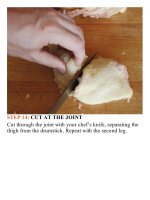The food lab better home cooking through science ( PDFDrive ) 371
Bạn đang xem bản rút gọn của tài liệu. Xem và tải ngay bản đầy đủ của tài liệu tại đây (184.58 KB, 2 trang )
45-secondwindowduringwhichyoucanpullitofftheheat
and have it be perfectly medium-rare.A tenderloin, on the
otherhand,goesfromunderdonetooverdoneinamatterof
seconds. Not only that, but fat also gives you a nice buffer
zone for overdoneness. Because fat lubricates and flavors
meat,anicelymarbledsteakwillstilltasteprettygoodeven
if it’s slightly overcooked. Not so for a tenderloin, which
turns pasty and chalky when cooked even a shade beyond
medium.
All this is to say that it requires quite a bit of skill and
patiencetocookatenderloinsteakproperly—atleastitdoes
if you’re doing it the traditional way. The last time I
overcookedatenderloin,Ithoughttomyself,asIoftendo,
“Shouldn’t there be a much easier, more foolproof way to
dothis?”
Indeedthereis.
The problem is that the high unidirectional heat of a
skillet or grill makes not overcooking a tenderloin steak a
very tough task indeed. So I first considered slow-roasting
the steaks in a relatively low-temperature 275°F oven until
perfectlycookedtomedium-rare,followedbyahardsearin
askillettocrispuptheedgesandbrownthem.Thatworked
reasonably well, but the window of time for perfectly
cooked steaks was still a matter of moments.So how do I
increase that window? I thought to myself.Why not just
cookthemeatasasinglelargeroast,thencutitintosteaks?
Becauseofitsmorelimitedsurfacearea,awholeroastisfar
easier to cook evenly than individual steaks, especially
when you consider that even with the most careful
butchering, not all steaks are going to be of an equal size
and shape, making it nearly impossible to cook them all to
theexactsamedegreeofdoneness.Alargerroastalsohasa
much bigger window for perfectly cooked meat by sheer
virtueofthefactthatitcooksmoreslowly.
I fired off another round, this time cooking a 2-pound
tenderloin roast whole until it reached about 20 to 30
degreesbelowmydesiredfinaltemperatureof130°F.After
removingitfromtheoven,Isliceditintofourevenlysized
steaks,gentlyflatteningeachone,thensearedtheminahot
skilletwithoilandfinishedthemwithbutter.Whatresulted
were steaks that were perfectly cooked from edge to edge,
with a beautifully browned crisp crust—far better cooked
than I’d ever managed using the traditional method. More
even cooking was a happy by-product of the method. A
steakcookedinthetraditionalwaywithhighheatfromthe
get-gowillendupwithagoodamountofovercookedmeat
toward the exterior—raw steaks have to sit in a hot skillet
foragoodamountoftimeastheydevelopagoodsear,and
all the while, they’re slowly overcooking. But a slow-









